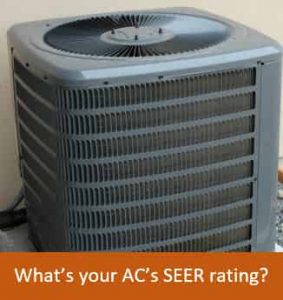When your HVAC system is running efficiently, it uses less energy while keeping your home or business or business comfortable. The Seasonal Energy Efficiency Ratio (SEER) rating of an air conditioner aids in determining its efficiency. The greater the SEER number, the more energy efficient your air conditioner is.
Understanding what this rating means will assist you in making an informed decision regarding the best air conditioning equipment for your needs.
What is a SEER Rating?

SEER ratings are obtained by dividing the annual cooling output of a unit by the total electric energy intake during the cooling season.
A SEER rating relates energy output to energy consumption, as opposed to BTU, which measures a system’s energy output. The SEER rating and BTU can be used to calculate the energy consumption of your air conditioning system.
For example:
If you have a 24,000 BTU air conditioner with a SEER of 15, and you operate it for 8 hours a day for a 125-day summer season, your total cooling output is 24 million BTU (24,000 BTU x 8 hours x 125 days). The system would use 1,600 kWh if it had a SEER of 15 (24,000,000 divided by 15 = 1,600,000 Wh).
While this is only an estimate, bear in mind that Texas summers are quite hot, and your home or business or business will most likely demand extra electricity to stay cool.
What is a Good SEER Rating?
Greater energy efficiency and savings are associated with a higher SEER rating. The minimum SEER rating for HVAC equipment is 13, with rates ranging from 13 to 21.
In addition, to be ENERGY STAR approved, air conditioners must have a SEER rating of 14.5 or higher.
Remember that the effectiveness of your system is affected by factors like as the size of your home or business or business, ductwork, and other factors.
What SEER Rating is Ideal for Your Home or business or business?
The appropriate SEER rating for your home or business or business is determined by a number of characteristics that are unique to each property, such as its location, size, and HVAC requirements. Furthermore, minimum SEER criteria are enforced by the US Department of Energy based on geographic area. The minimum SEER rating in the Southeast is 14.
Keep in mind that higher-SEER air conditioners are more expensive than lower-SEER models, so talk to your HVAC specialist about the energy savings you want from your unit.
Is a Higher SEER Rating Worth It?
A higher SEER rating may provide more comfort and energy savings, but the unit’s upfront costs will be higher. Higher SEER air conditioners are more likely to have advanced features like multi-stage cooling, which allows the unit to run for extended periods of time rather than continuously starting and stopping.
If you live in a humid climate, such as Texas, an air conditioner with a higher SEER rating will keep you considerably more comfortable.
Your Big Fish HVAC specialist will be able to propose a unit with a SEER rating that meets your individual needs.
Where Can I Find my AC Unit’s SEER Rating?
The SEER rating is placed on a bright yellow sticker on the outside of most air conditioners, with the words “Energy Guide” at the top. If you can’t find it, the SEER rating for your AC unit should be available online.
Austin Area Energy-Efficient Air Conditioning Systems
Call our staff at Big Fish HVAC if you’re looking for a new energy-efficient air conditioning system. We’ll go over SEER ratings with you and help you figure out what size unit and rating is best for your home or business or business.
Ready to get started? Call Big Fish HVAC today at 512-653-1414.



